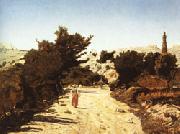Wholesale Oil Painting No Minimum |
|||||||||||
|
|
|||||||||||

|
|||||||||||
|
|
|
||||||||
Paul-Camille Guigou1834-1871 French Paul Camille Guigou Gallery French painter. Born into a family of landowners, he became a notary's clerk at Apt in 1851 and then in 1854 at Marseille. He learnt to paint with Camp, a teacher at the school in Apt, and then at Marseille with Emile Loubon (1809-63), director of the local Ecole des Beaux-Arts, who urged him (according to Guigou's biographers) to paint directly from nature. Guigou settled in Marseille in 1854, where he participated regularly in the annual Salon of the Societe Artistique des Bouches-du-Rhene. Guigou painted almost exclusively Proven?al landscapes, which were influenced by the works of the Barbizon painters, who exhibited in Marseille, and by the brownish tones and picturesque figures of Loubon's paintings. The Road to Gineste (1859) and The Washerwoman (1860; both Paris, Mus. d'Orsay) reflect the independent tradition of Proveneal painting during the Second Empire, which was characterized by warm colouring and precise lighting used to separate and distinguish forms. His knowledge of the works of Gustave Courbet, acquired during a visit to Paris in 1859, doubtless increased his liking for broad technique and sincere vision, articulated in a strong and ordered construction of space: for example, The Gorges of the Luberon (c. 1861; Amiens, Mus. Picardie). |
||||||||
|
|
||||||||
La Gineste Road
La Gineste Road Painting ID:: 11196 |
near Marseille,1859
2' 11'' x 3' 10''(89 x 117cm) near Marseille,1859 2' 11'' x 3' 10''(89 x 117cm) |
|||||||
|
CONTACT US |

